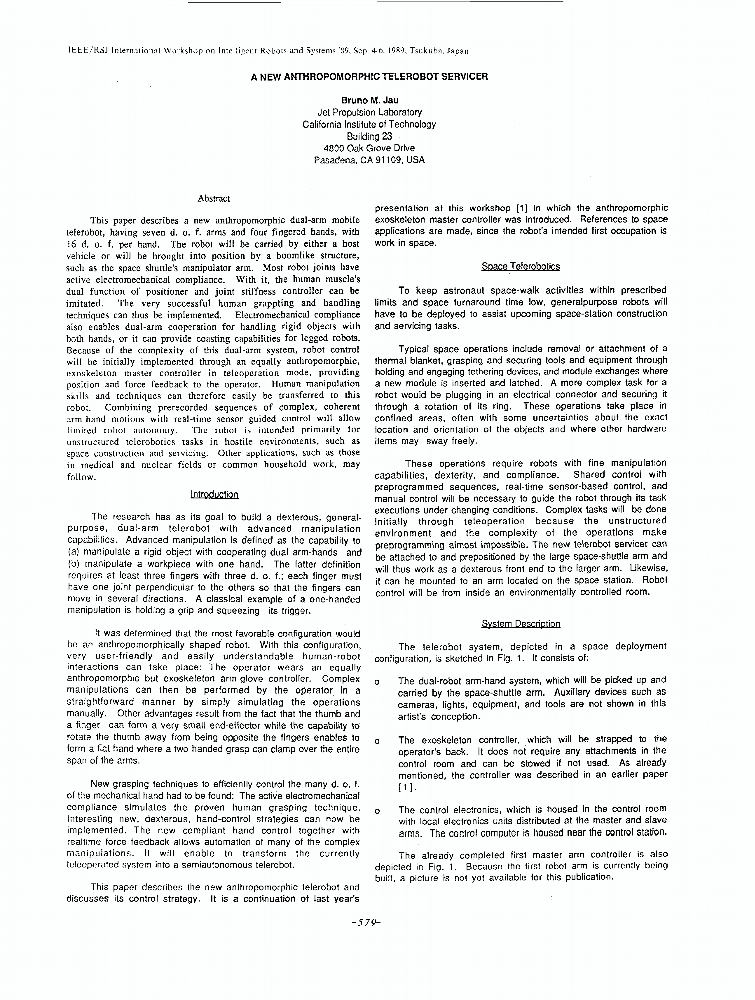Archive for Сентябрь, 2011
Path planning for encountered-type haptic devices that render multiple objects in 3D space
- Тип контента: Научная статья
- Номер документа: 1534
- Название документа: Path planning for encountered-type haptic devices that render multiple objects in 3D space
- Номер (DOI, IBSN, Патент): 10.1109/VR.2001.913796
- Изобретатель/автор: Yoshikawa, T., Yokokohji, Y., Kinoshita, J.
- Правопреемник/учебное заведение: Dept. of Mech. Eng., Kyoto Univ., Japan
- Дата публикации документа: 2002-08-07
- Страна опубликовавшая документ: Япония
- Язык документа: Английский
- Наименование изделия: Не заполнено
- Источник: http://ieeexplore.ieee.org/search/freesrchabstract.jsp?tp=&a
- Вложения: Не заполнено
- Аналитик: Не заполнено
 A path-planning algorithm for encountered-type haptic devices that render multiple virtual objects in 3D space is proposed. To render multiple virtual objects with a single haptic device, the following two behaviors must be realized: (i) the device should move to the target object location in advance of the user’s hand so that the user can encounter it; (ii) otherwise, the device should keep away from the user’s hand, avoiding an unexpected collision. To realize such a consistent encounter, the user’s hand motion must be tracked. The proposed algorithm determines the device location based on the minimum distance problem between a point (the user’s hand) and a convex polyhedron constructed from the reference points of multiple objects. An automobile virtual control panel was constructed using an encountered-type haptic device in which the proposed path-planning algorithm was implemented. The validity of the proposed algorithm was confirmed and the required performances, such as the device speed and the accuracy of hand tracking were evaluated.
A path-planning algorithm for encountered-type haptic devices that render multiple virtual objects in 3D space is proposed. To render multiple virtual objects with a single haptic device, the following two behaviors must be realized: (i) the device should move to the target object location in advance of the user’s hand so that the user can encounter it; (ii) otherwise, the device should keep away from the user’s hand, avoiding an unexpected collision. To realize such a consistent encounter, the user’s hand motion must be tracked. The proposed algorithm determines the device location based on the minimum distance problem between a point (the user’s hand) and a convex polyhedron constructed from the reference points of multiple objects. An automobile virtual control panel was constructed using an encountered-type haptic device in which the proposed path-planning algorithm was implemented. The validity of the proposed algorithm was confirmed and the required performances, such as the device speed and the accuracy of hand tracking were evaluated.
Категория: Ищем научные статьи | Нет комментариев »
A New Anthropomorphic Telerobot Servicer
- Тип контента: Научная статья
- Номер документа: 1532
- Название документа: A New Anthropomorphic Telerobot Servicer
- Номер (DOI, IBSN, Патент): 10.1109/IROS.1989.637961
- Изобретатель/автор: Jau, B.M.
- Правопреемник/учебное заведение: California Institute of Technology
- Дата публикации документа: 2002-08-06
- Страна опубликовавшая документ: США
- Язык документа: Английский
- Наименование изделия: Не заполнено
- Источник: http://ieeexplore.ieee.org/search/freesrchabstract.jsp?tp=&a
- Вложения: Не заполнено
- Аналитик: Не заполнено
Категория: Ищем научные статьи | Нет комментариев »
A methodology to design kinematics of fixations between an orthosis and a human member
- Тип контента: Научная статья
- Номер документа: 1530
- Название документа: A methodology to design kinematics of fixations between an orthosis and a human member
- Номер (DOI, IBSN, Патент): 10.1109/AIM.2009.5229776
- Изобретатель/автор: Morel, G., Jarrasse, N.
- Правопреемник/учебное заведение: ISIR (Inst. des Syst. Intelligents et de Robot.), Univ. P. et M. Curie, Paris, France
- Дата публикации документа: 2009-09-01
- Страна опубликовавшая документ: Франция
- Язык документа: Английский
- Наименование изделия: Не заполнено
- Источник: http://ieeexplore.ieee.org/search/freesrchabstract.jsp?tp=&a
- Вложения: Не заполнено
- Аналитик: Не заполнено
 The design of robotic orthoses focuses strongly on replicating kinematics of human limb. However, often sophisticated mechanisms which attempt at reproducing complex kinematics of human joints fails in adapting to geometrical variations of subjects sizes and eccentricities. One major that arises from this mismatching is an occurrence of hyperstaticity induced by the uncontrolled interaction forces. In this paper, we take the point of view of statics to investigate the force transmission problem, which is required for a fine force control. The main result of this study focuses on designing fixations between the orthosis and the human limb that provide additional degrees of freedom. The method involves two steps. Firstly, a set of possible solutions with respect to the isostaticity criterion is derived. Then, among these possible solutions, a set of design rules considering physiological aspects of transmitting forces to human limbs is used to select a preferred configuration. As an example, the method is applied to an existing 4 active DOF arm orthosis.
The design of robotic orthoses focuses strongly on replicating kinematics of human limb. However, often sophisticated mechanisms which attempt at reproducing complex kinematics of human joints fails in adapting to geometrical variations of subjects sizes and eccentricities. One major that arises from this mismatching is an occurrence of hyperstaticity induced by the uncontrolled interaction forces. In this paper, we take the point of view of statics to investigate the force transmission problem, which is required for a fine force control. The main result of this study focuses on designing fixations between the orthosis and the human limb that provide additional degrees of freedom. The method involves two steps. Firstly, a set of possible solutions with respect to the isostaticity criterion is derived. Then, among these possible solutions, a set of design rules considering physiological aspects of transmitting forces to human limbs is used to select a preferred configuration. As an example, the method is applied to an existing 4 active DOF arm orthosis.
Категория: Ищем научные статьи | Нет комментариев »
Fingertip stiffness control using antagonistic pairs of polyarticular tendons drive system
- Тип контента: Научная статья
- Номер документа: 1526
- Название документа: Fingertip stiffness control using antagonistic pairs of polyarticular tendons drive system
- Номер (DOI, IBSN, Патент): 10.1109/ROBIO.2009.5420498
- Изобретатель/автор: Sankai, Y., Iwaki, M., Hasegawa, Y.
- Правопреемник/учебное заведение: Dept. of Intell. Interaction Technol., Univ. of Tsukuba, Tsukuba, Japan
- Дата публикации документа: 2010-02-25
- Страна опубликовавшая документ: Япония
- Язык документа: Английский
- Наименование изделия: Не заполнено
- Источник: http://ieeexplore.ieee.org/search/freesrchabstract.jsp?tp=&a
- Вложения: Не заполнено
- Аналитик: Не заполнено
 This paper proposes a tendon driven system with antagonistic pairs of polyarticular tendons to simulate a variable stiffness of a human fingertip. The stiffness of a robot finger should be adjusted according to a situation that includes large position errors or collisions, because it tolerates errors of object positions and dimensions in assembly task and absorbs collision energy in hitting or catching task. The variable stiffness therefore contributes to stable grasping and dexterous manipulation. Besides, a stiffness of a human fingertip can be controlled by consciously contracting antagonist muscles when it does not contact anything such as in a preshaping phase. This study simplifies a tendon driven system of a human finger and then searches feasible parameter settings of the tendon driven system with antagonistic pairs of polyarticular tendons through numerical simulations. Finally it is experimentally confirmed that the proposed tendon driven system has similar stiffness to a human finger.
This paper proposes a tendon driven system with antagonistic pairs of polyarticular tendons to simulate a variable stiffness of a human fingertip. The stiffness of a robot finger should be adjusted according to a situation that includes large position errors or collisions, because it tolerates errors of object positions and dimensions in assembly task and absorbs collision energy in hitting or catching task. The variable stiffness therefore contributes to stable grasping and dexterous manipulation. Besides, a stiffness of a human fingertip can be controlled by consciously contracting antagonist muscles when it does not contact anything such as in a preshaping phase. This study simplifies a tendon driven system of a human finger and then searches feasible parameter settings of the tendon driven system with antagonistic pairs of polyarticular tendons through numerical simulations. Finally it is experimentally confirmed that the proposed tendon driven system has similar stiffness to a human finger.
Категория: Ищем научные статьи | Нет комментариев »
Workshop 2: Wearable lower limb exoskeletons
- Тип контента: Научная статья
- Номер документа: 1521
- Название документа: Workshop 2: Wearable lower limb exoskeletons
- Номер (DOI, IBSN, Патент): 10.1109/BIOROB.2008.4762761
- Изобретатель/автор: Не заполнено
- Правопреемник/учебное заведение: Не заполнено
- Дата публикации документа: 2009-01-27
- Страна опубликовавшая документ: Не заполнено
- Язык документа: Не заполнено
- Наименование изделия: Не заполнено
- Источник: http://ieeexplore.ieee.org/search/freesrchabstract.jsp?tp=&a
- Вложения: Не заполнено
- Аналитик: Не заполнено
Категория: Ищем научные статьи | Нет комментариев »
Статистика
Категорий: 179
Статей всего: 2,003
По типу:
Видео: 36
Выдержка с форума: 1
Контактные данные: 12
Научная статья: 1388
Не заполнено: 5
Новостная статья: 317
Обзор технологии: 42
Патент: 219
Тех.подробности: 34
Тип: 1
Комментариев: 9,509
Изображений: 3,005
Подробней...
ТОР 10 аналитиков
-
Глаголева Елена - 591
Дмитрий Соловьев - 459
Helix - 218
Ридна Украина))) - 85
Наталья Черкасова - 81
max-orduan - 29
Елена Токай - 15
Роман Михайлов - 9
Мансур Жигануров - 4
Дуванова Татьяна - 3
Календарь
Авторизация
Ошибка в тексте?
Выдели её мышкой!
И нажми Ctrl+Enter


